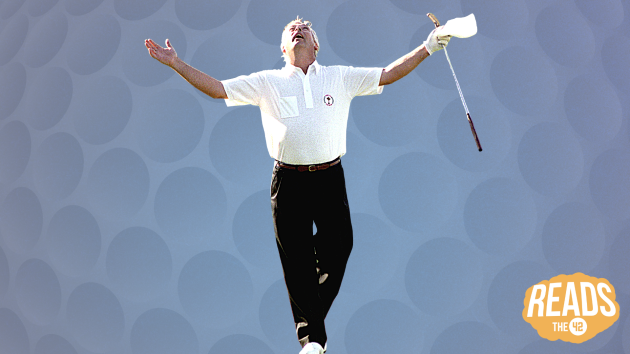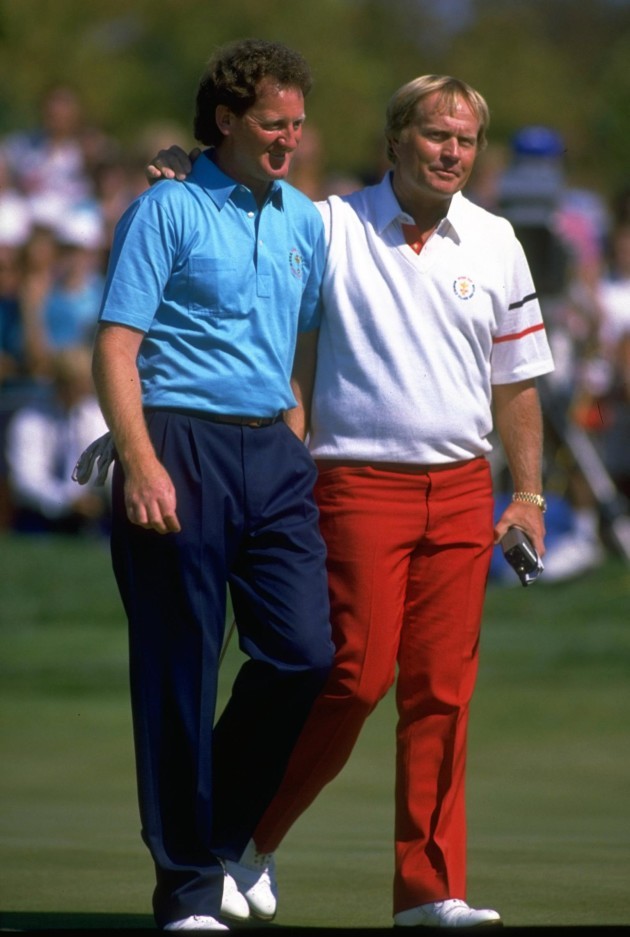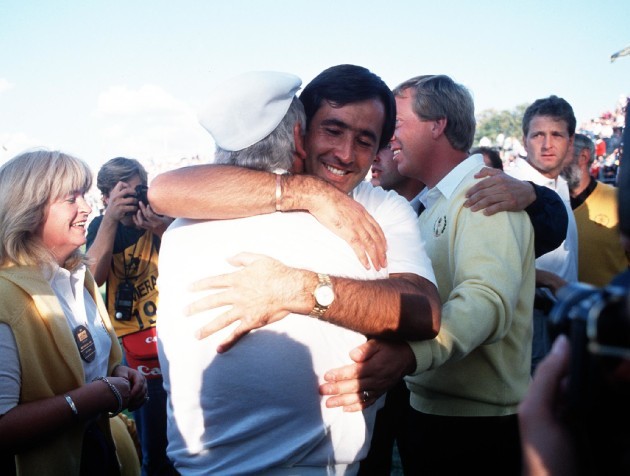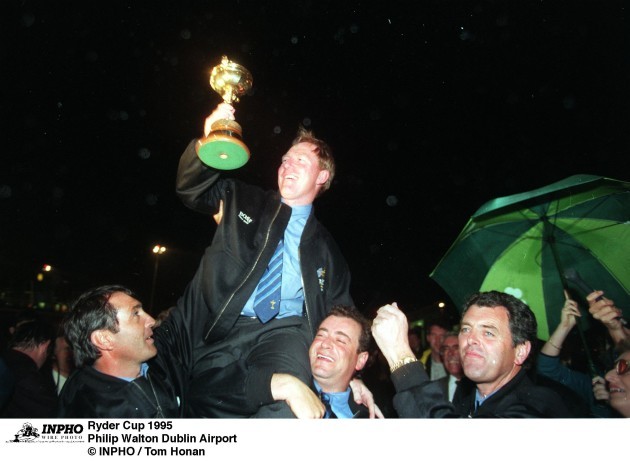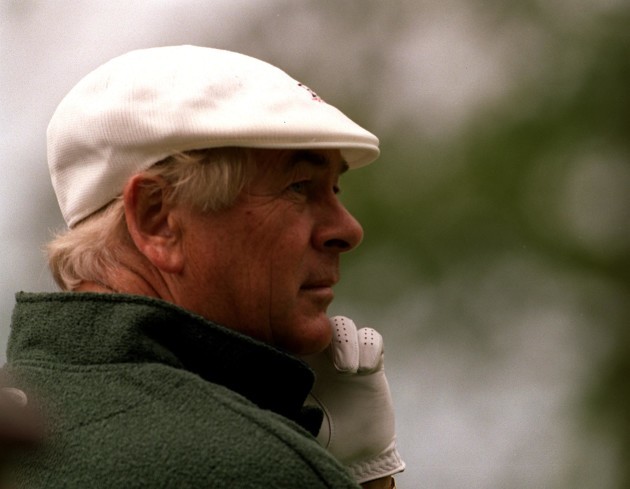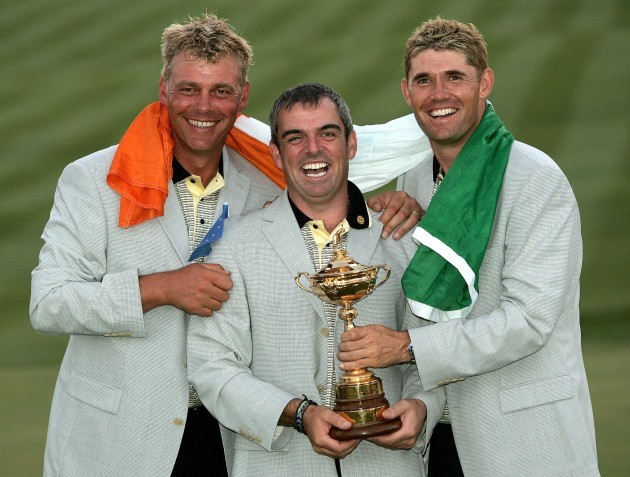PART ONE: GLORY DAYS
THE WORLD IRISH golf wanted into was the world of Ben Crenshaw.
Ben Crenshaw. World No1, beautiful swing, even better looking bank balance. If Irish golf was all beige trouser and v-neck sweater, then the US scene was stylish and bright. And Crenshaw – winner of the ’84 Masters, winner of 12 PGA titles by the time the ’87 Ryder Cup was staged – embodied all that.
As for Eamonn Darcy, as for Irish golf, well it would be impossible to imagine now how different the landscape looked back then.
Before Pádraig Harrington’s breakthrough at Carnoustie, only one Irish golfer had ever won a major. Worse again, there were decades when no one came close — Christy O’Connor Jnr the only Irishman to hold an outright lead at the end of any major round between 1964 and 1997.
Yes, European golf was on the rise on the back of their 1985 Ryder Cup win – but that was at The Belfry and that was achieved without a single Irish player in the team.
- For more great storytelling and analysis from our award-winning journalists, join the club at The42 Membership today. Click here to find out more>
Two years later in Muirfield, Ohio – history’s scrapbook was willingly holding space for another chapter to be written. Never before had a European team won on American soil but after the Friday four-ball, that looked set to change. “I’ve never seen golf played so well,” said Jack Nicklaus that afternoon.
Leading by five-points heading into the singles, the contest was seemingly over. Not quite. Howard Clarke was the only European to win in the first seven matches on singles Sunday, Darcy the eighth European out.
Big deal? Not to Darcy. His swing may have been openly mocked; his prior record in the competition – two halves from 10 matches – may not have inspired confidence but the Delgany-man was a fighter and was two up on Crenshaw when ‘Gentle Ben’ lost his temper on the sixth, snapping his putter in frustration. The Texan would putt with a one iron for the rest of the match, recovering from three down at the turn to lead by one.
All around, Europeans were drowning; major winners Sandy Lyle, Ian Woosnam, Jose Maria Olazabal and Nick Faldo losing games they were expected to win.
The scoreboard was mostly red. That was about to change. Darcy tied things up on 17, and then on 18, Crenshaw’s tee shot ended up in the water, his third in the bunker.
Trouble was Darcy was also in the sand in two. To win the game, he needed to hole a hellish, downhill putt from five feet. “I only touched it,” said Darcy, “because it would have been suicide to hit it any harder.”
It’s remembered as the winning putt yet it wasn’t. That honour belonged to Seve Ballesteros who defeated Curtis Strange 2&1 a few minutes later. “Look, I didn’t win the Cup,” Ballesteros said graciously. “In reality, it was Eamonn. His win was the key one.”
**
By the time 1989 came around, Fred Couples was three years away from becoming world No1. Again, the tournament was in the balance on the final day, again Europe had lost their way on singles Sunday.
And again an Irishman found himself in the game’s key match, heading down the 18th, seemingly in trouble, 215 yards from the pin with a 2-iron in his hand. Couples – the longer hitter – only needed a nine-iron to reach the green.
It’s at this point that it’s worth pointing out that in golf, the Ryder Cup is like an Olympic final, every other tournament – in comparison – little more than a fun run.
That’s why you see champions fall apart; superstars play like hackers. On the flip side, sometimes good guys join the immortals.
That was O’Connor in ’89. His second to the green, a 2-iron that landed four feet from the hole, is one of the most replayed shots in Ryder Cup history. Couples may have won 46 more professional tournaments than O’Connor in their respective careers yet it was Junior who prevailed in ’89.
“I couldn’t handle the pressure,” said Couples, two years later, “whereas Christy hit the shot of a lifetime.” Sadly, though, it would be his final act in the competition. He never played in the Ryder Cup again.
**
The great American sportswriter, Jim Murray, described golf as a head-wrecker rather than a sport: “It is an obsession. A boulevard of broken dreams,” Murray wrote. “It teases you, taunts you. It plays with men. And then runs off with the butcher.”
Still, it is an addictive sport, one that keeps bringing people back to it. Why else would Philip Walton put up with the pain he suffered in 1991 when the yips had taken over his life?
An introduction to a broom handle putter changed his career. By 1995, he won twice on the European tour to squeeze into the team as the last automatic pick. The guy behind lost out by just €4,186.94.
Like O’Connor and Darcy, though, Walton had honed his competitive spirit in Irish golf’s amateur circuit. Matchplay energised him. “It brought out the best in me,” he’d say. And the worst in others.
Take Jay Haas. The American had three top-ten finishes in the majors in 1995 which is three more than Walton managed in his career. Yet even though he was the only player in that year’s Ryder Cup ranked outside the world’s top 100, when he stood opposite Haas on the first tee, Walton immediately sensed an opportunity. “He looked nervous,” said the Irishman.
To the outside world, Walton against Haas was a little like Bruno against Tyson; Tonga against the All Blacks; Leitrim against Kerry; the coastline against the tsunami. But it was the Irishman who settled first, and who was three up with three to play.
Nonetheless, the game went down 18. The only difference with Darcy and O’Connor is that Walton’s putt doubled up as the moment the Cup was officially won.
It didn’t look like it would end that way after 17, when Walton lipped out from four feet. All the momentum was with Haas at that stage. The American, however, lost his nerve.
“Haas hit a terrible tee shot,” Walton told The Sunday Times’ Denis Walsh a few years later. “A sky hook. I’ve never seen a pro hit a tee shot like that in my life.”
By the time they reached the green, Walton needed two putts for the win. He didn’t hang about taking them. Like Darcy and O’Connor, he was a Ryder Cup hero. But like Darcy and O’Connor, his high point was also the end point.
PART TWO: CURSED
In fact things would get a lot worse for Walton.
“About two years after that the game started to go a bit,” he’d say. “Well, not the game really, the head started to go a bit. Lost my confidence. In 1999 I made 12 cuts, and made them all in big money tournaments, and I made about £25,000 in prize money. The head, the confidence was gone.”
So was his Tour card. The spirit was still there, though. Despite his hard-luck story, he kept returning to Tour School, seeking to get his European Tour card back. He got there in 2005 but struggled the following year, making just two cuts. In ’95 at Oak Hill, he was king of the hill but would never get back to those heights.
Darcy, too, had to welcome adversity to his door. By 1991, he was back in form, in ninth position prior to the final qualifying tournament for that year’s Ryder Cup. He opted not to play in it. Paul Broadhurst did, however, doing enough to overtake Darcy by a mere £58.26 in prize money.
That’s golf. It’s a cruel game. But you can get over bad shots, bad luck, even bad years. There are some things that life throws at you, however, that go way beyond misfortune.
PART THREE: TRAGEDY
He knew something was wrong. Was it the fact Darren hadn’t picked up the phone? Or was it simply a parental premonition? Dining with his wife and daughter, troubled by his failure to contact his son, Christy O’Connor Jnr felt his life was about to change forever.
Half-an-hour earlier, his old life was played out in a series of conversations and photographs. From the moment he had walked through the restaurant’s front door, strangers casually approached him, shyly requesting his autograph, inevitably asking about that 2-iron from The Belfry. And each time he reminisced about the 1989 Ryder Cup, he oozed charisma. Slowly, the numbers around him increased. Seduced by his celebrity and natural decency, people wanted to be in his company.
Yet when he’d later speak about that day, he’d remember it as the loneliest of his life. His phone rang. “And I knew it was about Darren,” he’d later say.
Darren was his son, a precocious golfer who had his entire life in front of him, when he set out on a drive to Killarney.
Tragically, he never made it that far. His car crashed and three people died. And one hundred miles away, Christy O’Connor Jnr- one of the most loved golfer’s in Ireland’s sporting history – predicted the worst. “There was an awful, awful feeling,” he’d later say. “I had this sense. I prayed for Darren to make it through. My wife and daughter, we all prayed, as we drove down home. When he died, my heart was broken. When you lose a child …… you lose a part of yourself.”
Five years ago the world lost O’Connor. He was 67, a golfer whose warmth of personality bought him a special place in the locker room. “Christy wasn’t just a member of the European tour,” Ballesteros once said. “He epitomised what the tour was about. He’s a good man.”
And he was a fine golfer, one whose career began in 1967, when Junior was attached to his name to set him apart from Himself, Christy O’Connor senior, his uncle. Four victories on tour – including the 1975 Irish Open – was a scant return for his talent, which manifested itself in that 1989 Ryder Cup.
He would go on to rebuild his career and his life on the senior tour, winning back-to-back British Senior Opens as well as two victories in the United States, before an accident at home ended the revival.
With his ankle broken – at one stage amputation was considered – it seemed unlikely that O’Connor would ever golf again. And then, one by one, the letters started arriving, Nicklaus sending one, before Peter Alliss’s and Dave Stockton’s arrived. What they wrote was ‘get better’ but what the messages really said was how deeply loved O’Connor was. Why else would all the players on tour go out of their way to sign a huge get-well card? And why would their caddies send a separate card? “Why? Because he is a special man,” Ballesteros said.
When O’Connor considered retirement, Ballesteros wrote: “If you give up golf, you give up me.”
He kept going. Once, on a holiday in Kenya, he nearly drowned. Another time, a helicopter he was travelling in, crashed.
O’Connor survived those incidents but not the sudden illness which cost him his life in January 2016. When news broke that day, all the sports bulletins replayed a shot from 27 years earlier. It was a moment frozen in time, his lasting legacy.
PART FOUR: LEGACY
Some of you may look upon these stories as golf’s version of The Waltons, an unnecessarily indulgence in nostalgia?
But is it? Think about this year’s Ryder Cup, the sold-out signs outside Whistling Straits, the illogical belief in the European locker room that they are going to win against a team who have eight players in the world’s top ten.
What’s all that based on? Well, for the European captain, Harrington, and the rookie, Shane Lowry, the events in Oak Hill, The Belfry and Muirfield have certainly influenced them, this memory of Irishmen overcoming sporting prejudices that told them that golfers from this country should always lose to ones from the US.
Deeper than that, however, it is about keeping a show on the road. Up until 1985, the US had dominated the Ryder Cup. If Darcy hadn’t holed that putt in ’87, would O’Connor – or some other European – have crumbled in ’89?
Had Walton not conquered his putting demons prior to ’95 would Europe have prevented a hat-trick of US wins? Remember, Europe have won eight of the 11 tournaments since Walton’s magic moment. Prior to then, the US had lost just twice since 1957.
So try telling the players in today’s locker room that those heroic moments from Darcy, Walton and O’Connor carried no relevance, that they didn’t influence Paul McGinley – who sank the winning putt in 2002 – Darren Clarke, Graeme McDowell, Rory McIlroy or this year’s captain, Harrington?
There isn’t a player on the European Tour who is not in their debt. Prize money in 1987, Darcy’s year at Muirfield, was miniscule compared to now, Ian Woosnam topping the Order of Merit with £253,717.
Where would the European Tour be now if it wasn’t for the Ryder Cup? Would there even be a Tour? Aside from its dependence on the tournament for financial purposes, its identity is tied up in this bi-annual event.
So is Irish golf. When Thomas Bjorn was asked about McGinley’s loss of form before the 2004 Ryder Cup, he deadpanned: “You have to remember that Paul is Irish,” he said, “and the Irish seem to win Ryder Cups.”
Darcy was the first in the modern era to do so. O’Connor’s shot from heaven didn’t actually secure the ’89 Ryder Cup – indeed it was Jose Maria Canizares who holed a two-footer against Ken Green to retain the trophy.
Yet for an American audience, it was O’Connor’s shot which gave birth to a new reality, that this was a competition worth paying to see. The ’89 showdown was the first Ryder Cup played in Europe televised live in the United States. Prior to then golf fans stateside had to wait a month before a highlights package was shown on ESPN.
After ’89, seeing their team travel overseas on a tide of patriotism, networks saw the potential for great TV. NBC bought the initial rites. Every network competes fiercely for it now, the Cup generating €100m in revenue between TV, commercial and ticket sales, when it was last played, three years ago. “Historically, the Ryder Cup has really been utterly critical for the Tour,” said Nathan Homer, the European Tour’s chief commercial and marketing officer.
That comes down to the fact it is competitive. Up until 1985, it wasn’t. Darcy, O’Connor and Walton did their bit to change perception as well as history.
For more great storytelling and analysis from our award-winning journalists, join the club at The42 Membership today. Click here to find out more>

